27 Ways To Grow Your Email List, Backed By Data

Marketers have to keep up with a lot of fast changes. But amid the ever-changing social media landscape and the latest digital fads (looking at you, TikTok dances), there’s one thing that’s stayed pretty much the same for decades: email.
Despite being one of the oldest marketing channels in the digital world, it’s also one of the most effective by far. Its ROI is an impressive $36 for every $1 spent.
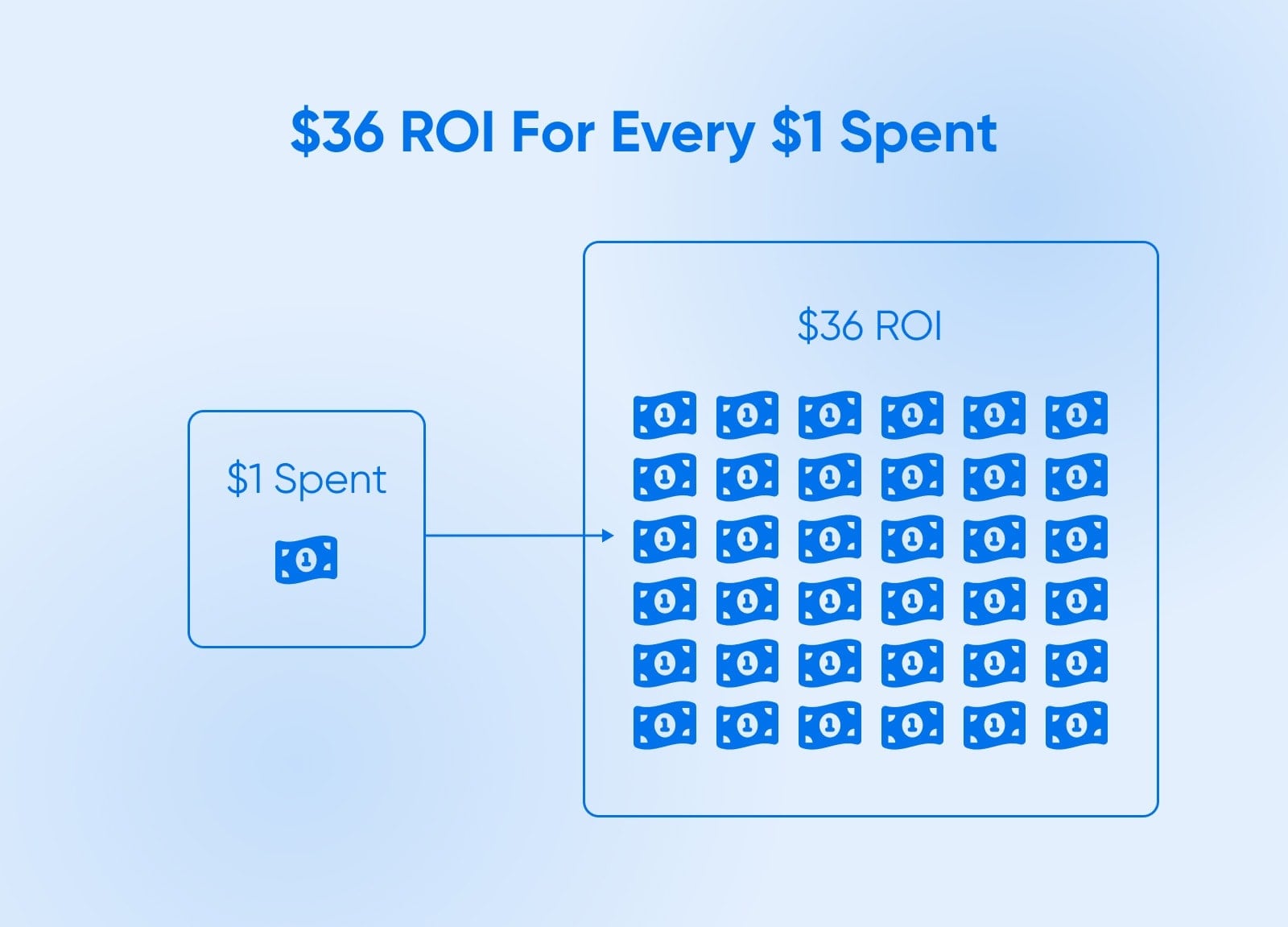
So whether you’re a seasoned marketing wizard, a savvy business owner looking to expand into more digital spaces, or a budding blogger looking to build your first audience, there’s a ton of value in growing an email list. But what are the best ways to do that?
Read on, and you’ll find 27 data-backed strategies to grow an email list effectively, from leveraging social media platforms and optimizing website sign-up forms to implementing referral programs and content marketing strategies.
These tips have the proof to back them up, so you know they’re great places to start when you want to expand your email subscriber base.
Let’s start with some basics, and then we’ll dive into the list of strategies.
What Is An Email List?
An email list is a collection of email addresses that you collect using various lead generation strategies, like sign-up forms, pop-ups, ads, or even email marketing software.
You can use your email list in a wide variety of ways: to send promotional emails, gather customer feedback, make business announcements, and more. But your email list isn’t just any crowd — it’s made up of current and prospective customers who have opted in, giving you the green light to drop into their inboxes with news, insights, offers, and whatever else you choose to share.
It’s personal, direct, and, when done right, incredibly effective.
Think of your email list as more than just recipients for email marketing campaigns. It’s your VIP club, where members get exclusive access to your thoughts, offers, and behind-the-scenes peeks that the average browser on your site might not see.
Get Content Delivered Straight to Your Inbox
Subscribe to our blog and receive great content just like this delivered straight to your inbox.
Why Do You Need To Grow Your Email List?
Why, in an era overflowing with social media platforms and digital channels, is it so important to build an email list? Here are a few good reasons:
- Ownership – Unlike your followers on social media, you own your email list. Algorithm changes? Platform updates? They won’t keep you up at night because your email list is yours, no matter which way the digital winds blow.
- Direct communication – Email is the equivalent of a cozy chat over coffee. It’s direct, personal, and uninterrupted by competing ads or cat videos (unless you’re the one sending them).
- Customization and segmentation – With an email list, you can slice and dice your audience into specific segments, tailoring your messages so they resonate deeply with different groups. This isn’t just throwing darts in the dark; your email marketing strategy can be targeted and data-backed.
- Engagement and conversion – Emails have a way of turning casual browsers into engaged followers and, eventually, loyal customers. The level of engagement and conversion potential here is unmatched, with studies consistently showing email marketing as one of the highest drivers of ROI. According to ActiveCampaign, average conversion rates for email marketing efforts tend to be around 15%. That’s much higher than other types of digital marketing.
Conversion
A website conversion is any action a user takes on a site that moves them further into the sales funnel. Examples include filling out a web form, clicking a call to action, or purchasing a product.
Read More27 Ways To Start Growing Your Email List
In the world of email marketing, there’s no one-size-fits-all solution. What works wonders for a bustling e-commerce site might be different for a contemplative blog. That’s the beauty of it! This treasure trove of strategies offers something for everyone, regardless of your niche, audience size, or business model.
From leveraging the latest tech innovations to revisiting timeless classics with a twist, these 27 strategies are the most proven ways to grow your email list.
1. Create Great, Unique Email Content
High-quality content is the cornerstone of any successful email list, because your email outreach efforts will only work if recipients want to receive what you’re sending.
Think of your emails as a special blend of coffee only you can brew; each sip (or click) offers a rich, satisfying taste (or read) that leaves your audience craving more. Crafting relevant content that resonates, educates, or entertains (and ideally, all three) is key. And don’t forget subject lines that entice your potential customers to open your emails in the first place; otherwise, they won’t even get to the content.
According to Statista, more than 347 billion emails are sent and received each day, and Campaign Monitor reports that 64% of small businesses use email marketing to reach customers. If you want to stand out amid so much email, your content has to be king (or queen).
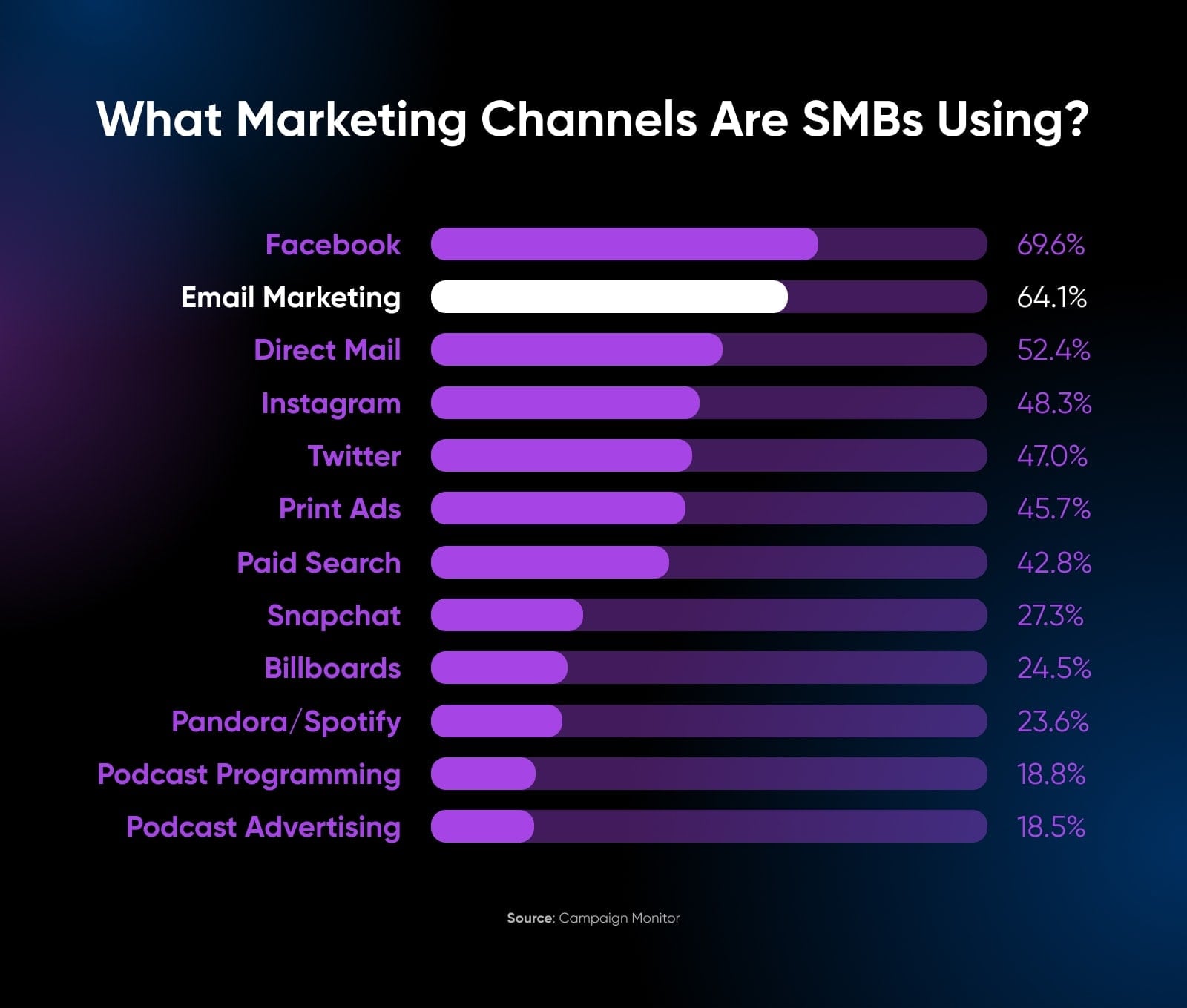
2. Start An Email Newsletter
Launching an email newsletter is like opening a direct line of conversation with your audience. It’s your platform to share insights, updates, stories, and everything in between. The trick is consistency and value — delivering content so good that your email subscribers mark their calendars in anticipation. Whether it’s weekly, bi-weekly, or monthly, a newsletter not only keeps your newsletter subscribers engaged but also solidifies your place in their digital routine — And it’s a proven technique. According to the Content Marketing Institute, 81% of B2B marketers say their most used form of content marketing is email newsletters.
3. Add An Opt-In Form to Your Website
Opt-in forms are powerful, but the key to making them as effective as possible is visibility and simplicity. Keep in mind that the more information you request and fields you include, the less likely visitors will be to complete the form.
Place your opt-in form in prime real estate: above the fold, on your homepage, or at the end of captivating blog posts. Make the sign-up process as straightforward as possible; a name and email address are often all you need.
Ruggable, a company that sells washable rugs, has an opt-in form built into the footer of their site, so it’s available on every page.
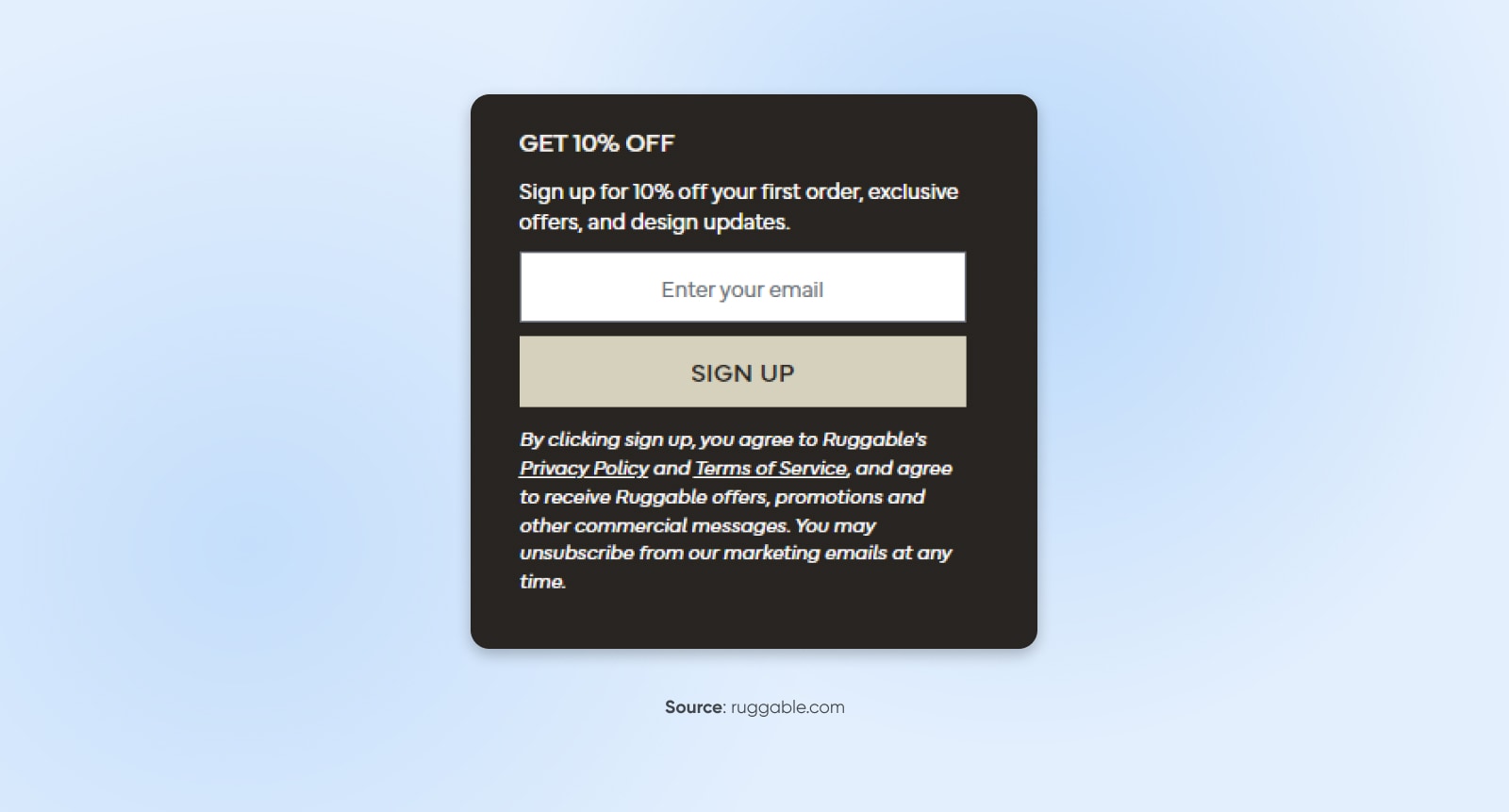
Looking for a WordPress plugin that makes it easy to create forms for your site? Both WPForms and Ninja Forms have drag-and-drop form builders that let you customize fields, change your form’s style and appearance, and more.
4. Use Pop-Ups Strategically
Pop-ups can be a double-edged sword. When used wisely, they’re incredibly effective; when abused, they’re downright annoying. A study from OptiMonk found that the average conversion rate for their top-performing pop-ups was 42.35%.
The art is in the timing and the offer. For example, exit-intent pop-ups, which trigger pop-up windows when a visitor’s cursor goes out of your website’s frame, can capture attention right when they’re about to leave, offering them a compelling reason to subscribe (think: discount codes, free guides, exclusive content).
Similar to opt-in forms, keep popup forms short and sweet, only collecting as much personal information as necessary. Remember that the goal is to add value, not disruption, to the user experience.
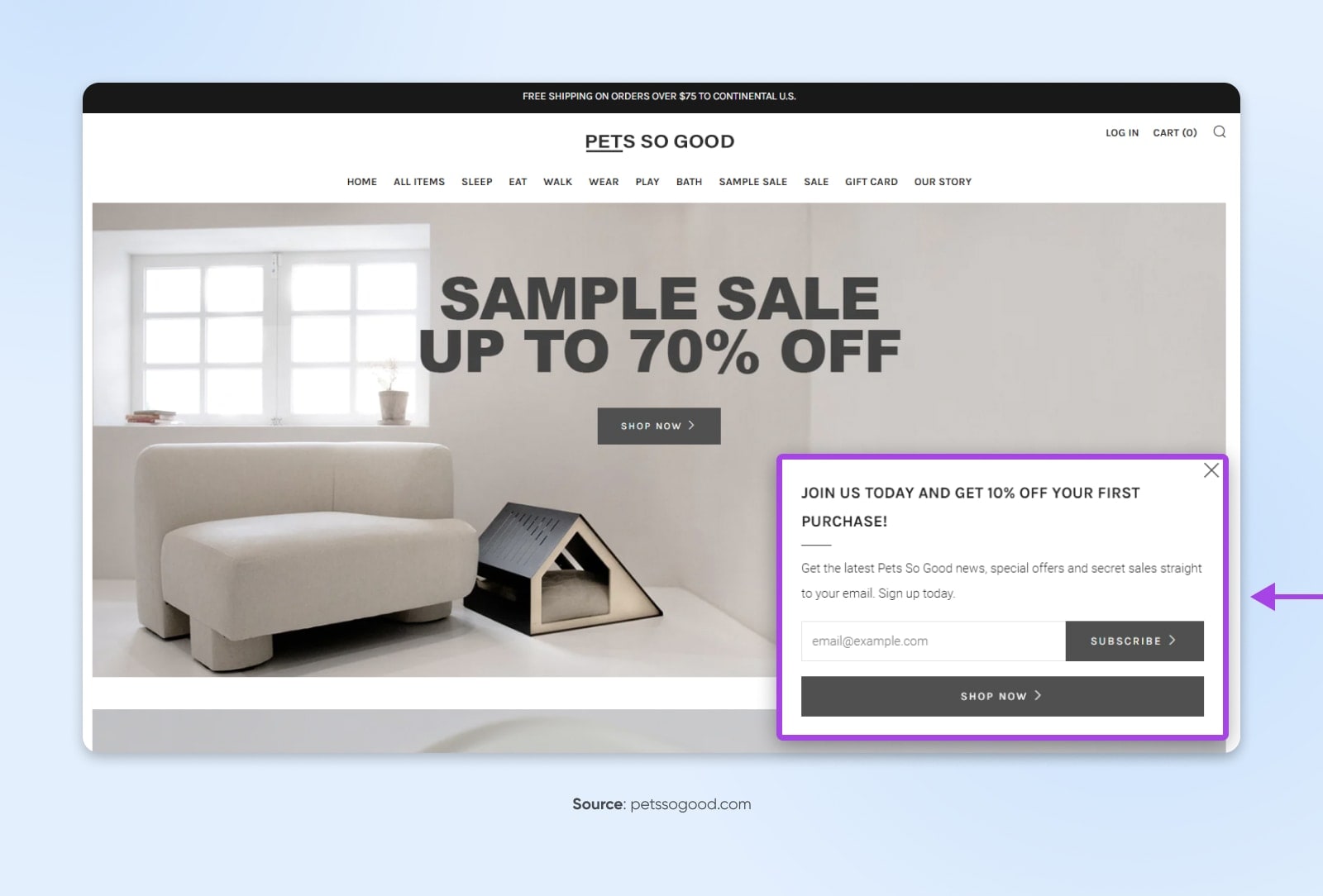
Here’s an example from a pet brand, Pets So Good. The opt-in pops up in the lower right-hand corner so it’s noticeable but not intrusive to your shopping experience.
5. Make Forms Mobile-Friendly
This tip may seem obvious, but in today’s on-the-go world, if your sign-up forms aren’t mobile-friendly, you’re missing out on a massive slice of the audience pie.
Nearly 55% of global website traffic is generated from mobile devices, excluding tablets, according to Statista. So if your email signup forms are easy to navigate on mobile, you’ll get more sign-ups, plain and simple. Ensure that fields are easy to fill out, buttons are thumb-friendly, and the overall experience is seamless across all devices.
6. Collect Data From Abandoned Forms
Ever wonder about the ones that got away? We’re not talking about past loves. We mean potential subscribers who start filling out your form but, for some reason, abandon ship before hitting “submit.”
WPForms has found that 81% of people have abandoned a form after starting to fill it out, and the average form abandonment rate is 68%. If you use WPForms to build your opt-in forms, you can activate an add-on that captures partial entries so you can follow up with those leads and invite them to come back and finish signing up for your email list.
7. Prevent Bots From Signing Up
Email deliverability matters. Once your deliverability starts to drop for one reason, that tends to trigger other deliverability issues. That’s just one reason why it’s so important to keep bots off your email list. Enter CAPTCHA and other verification methods, ensuring that every sign-up is a real person genuinely interested in what you have to offer. Keeping bots at bay means maintaining a clean, engaged list, and boosting your email deliverability and engagement rates. It’s about quality, not just quantity.
8. Offer A Welcome Discount
Who doesn’t love a warm welcome, especially when it comes with perks? Offering a welcome discount code can be the golden ticket that turns a website visitor into a subscriber and, eventually, a customer. It’s a win-win: they get a sweet deal, and you get a new addition to your email list, eager to engage with your brand. Plus, it’s effective. A Google study found that 90% of customers are willing to give up their email address in exchange for an incentive.
Cosmetic company, e.l.f., invites you to sign up for their email list to receive $5 off your purchase when you navigate to a product page.
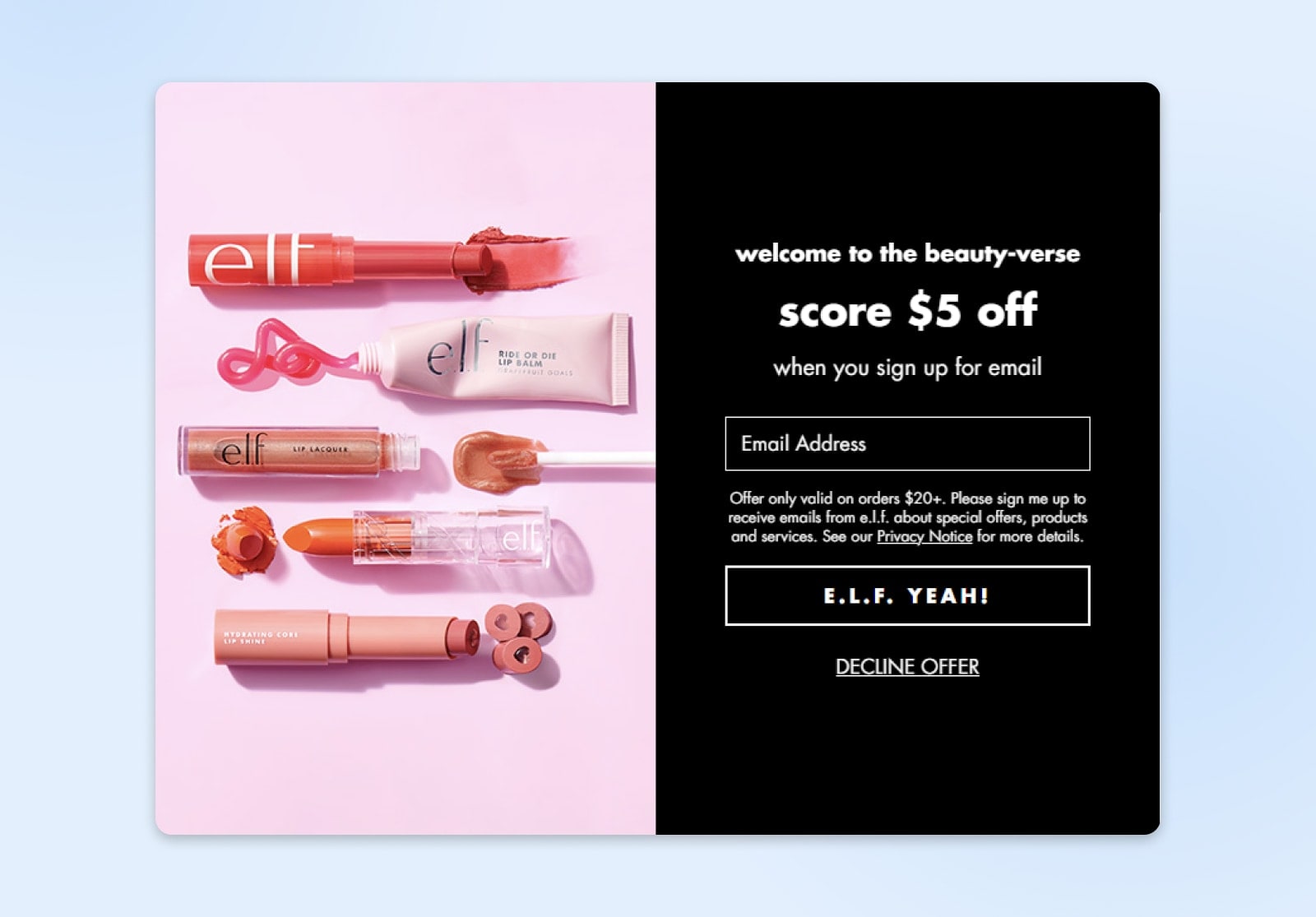
This strategy works well because it incentivizes visitors to make a purchase right away. However, it’s one of the most expensive strategies on this list, so only use it if your budget allows.
9. Host A Challenge Or Gamified Campaign
Hosting a challenge or a gamified campaign is a great way to encourage customers to engage with your brand and share their information. Contests have a conversion rate of almost 34%, which is much higher than other types of content, and 62% of participants share contest content with friends to encourage them to enter, too.
Whether it’s a fitness challenge, a creativity contest, or a quiz, the key is to make participation irresistible — and exclusive to those who sign up for your email list.
10. Host A Giveaway
Everybody loves free stuff, making running an online giveaway a surefire way to attract attention and new subscribers. Make email sign-up a condition for entry, and make sure the prize is something your audience truly wants, and you might just have a winning combination.
You can offer up your own products, but you don’t have to: a giveaway is a great time to partner up with other brands or host a sponsored event. Just make sure to be mindful of your partnership and don’t go for deals with irrelevant or subpar products that risk putting off your audience.
But do giveaways work? According to RapplePress, yes; they have a conversion rate of almost 34%. And, by the way, if you need a good WordPress plugin for running an online giveaway, RafflePress is worth a try.
Plugin
WordPress plugins are add-ons that enable you to extend the Content Management System’s (CMS) functionality. You can use plugins for almost everything, from adding e-commerce features to WordPress to implementing page builders or using Search Engine Optimization (SEO) tools.
Read More11. Put On A Webinar
Webinars are the digital equivalent of a seminar, only without the stuffy conference room and stale coffee. Hosting a webinar gives you a platform to share your expertise, connect with your audience in real-time, and, you guessed it, grow your email list.
For example, a mortgage professional and loan officer like Joe Soto may hold a free webinar on repairing your credit.
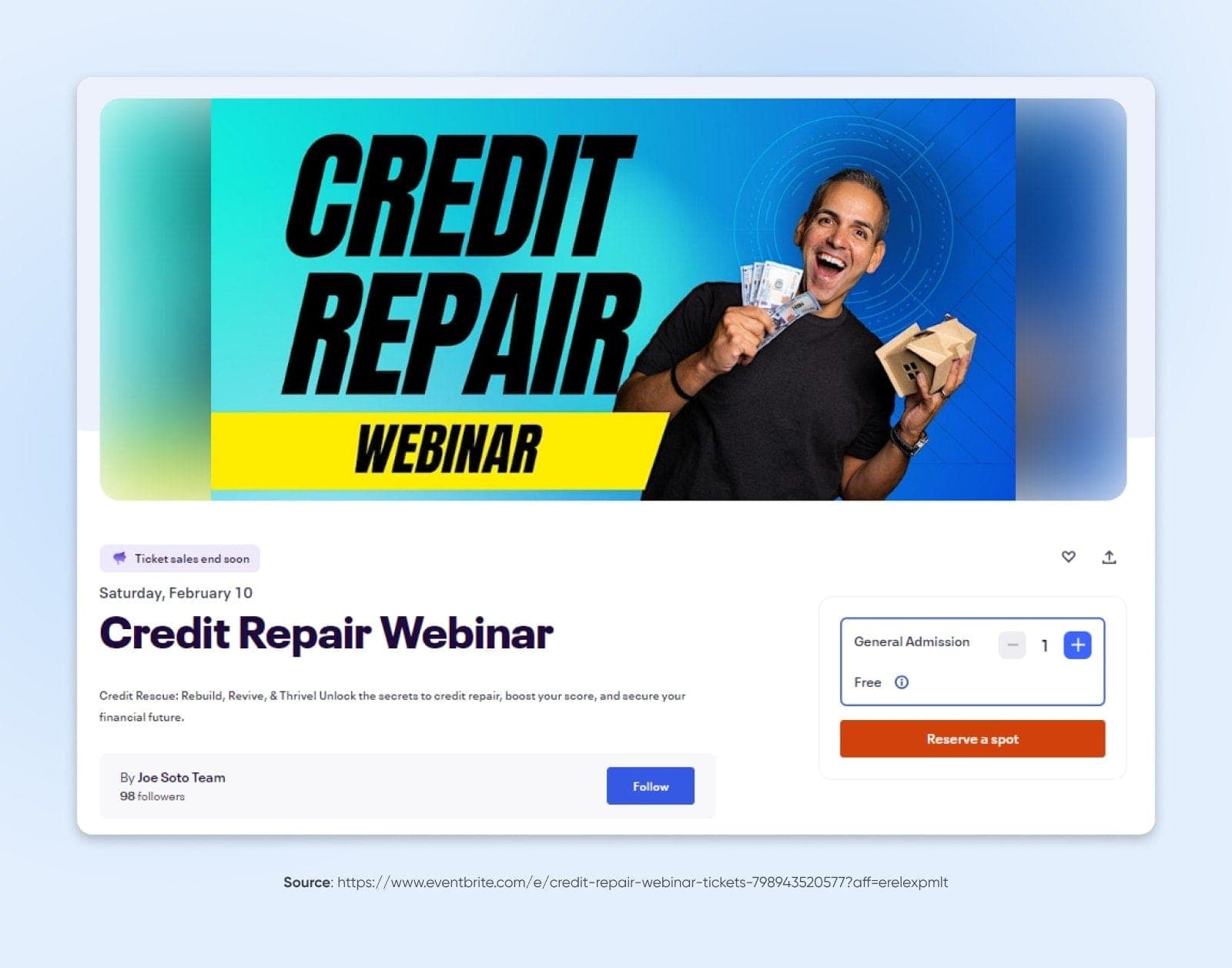
By requiring registration via email, you boost your subscriber count and connect with individuals genuinely interested in what you have to offer. Webinars also help you build credibility in your niche. According to an On24 report, 95% of marketers say webinars are a key part of their lead-generation efforts, and 74% say they can tie webinars directly to revenue. That means that while hosting a webinar is a high-effort strategy for building your email list, it’s likely to pay off.
12. Create An Email Course
An email course is similar to an online class, but you deliver it to recipients’ inboxes. You can automate the course to arrive over a few days or weeks in easily digestible parts, and while each class arrives on a set schedule, recipients can choose their own pace to open, consume, digest, and apply the information in the course. There’s no follow-up, feedback, or grading required, and email courses are a great way to repurpose older content, like from your blog.
This can be a great way to drive engagement with your email offerings. Remember that 90% of people will give away their email address for an incentive? It doesn’t need to be a discount or a freebie — the incentive can be knowledge via an email course.
13. Use Social Proof
Social proof is a powerful motivator, especially when it comes to growing your email list. Showcasing testimonials, subscriber counts, or success stories not only boosts your credibility but also creates a sense of community. Social proof definitely works: 79% of consumers trust an online review as much as a recommendation from their own friends or family.
14. Put CTAs In Social Media Posts
Call to Action (CTA)
A Call to Action (CTA) is a button or link that prompts users to complete an action, such as joining the email list, making a purchase, or downloading a document.
Read MoreYour social media accounts are prime real estate for growing your email list. But it’s not just about posting links to your sign-up form; it’s about crafting compelling calls to action (CTAs) that entice your followers to take the leap to sign up for emails.
CTAs are extremely effective to add to any copy. One study found that adding a CTA to an email campaign boosted conversions by 1,617%.
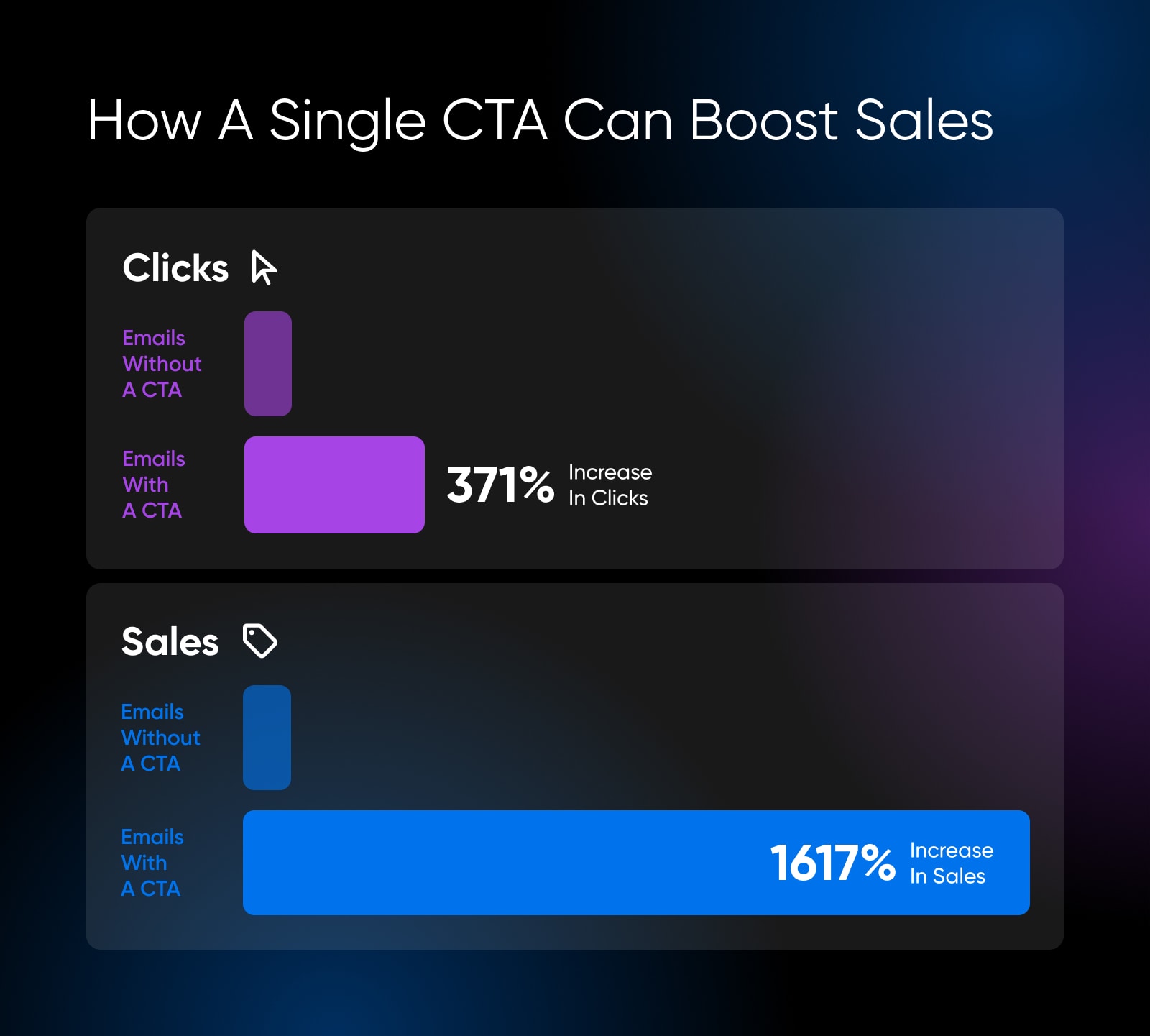
15. Use CTAs Strategically In Content (And Not Just At The End)
Social media posts aren’t the only place you should put CTAs. They should also be in your other content. But if your call-to-action is always playing the closing act, you might be missing out on potential subscribers.
The truth is, not everyone makes it to the end of your content. That’s why sprinkling CTAs throughout your blog posts, videos, and even podcasts can capture the attention of readers and viewers at different stages of engagement. There’s data to back up this strategy. A study by KISSmetric showed that CTAs embedded in videos received 380% more clicks than buttons.
16. Put A Signup Link In Your Email Signature
Your email signature is like your digital business card — every email you send is an opportunity to connect. So, why not make the most of this prime real estate by including a signup link to your newsletter or email list? It’s a subtle yet effective way to grow your list, turning every email correspondence into a chance for new subscriptions.
Even better if the link in your signature is a sign-up button; according to Copyblogger, CTAs shaped like buttons get 45% more clicks.
17. Put A Signup Link In Your Marketing Emails
This might sound like preaching to the choir, but hear me out. Including a signup link in your marketing emails (yes, the ones already going to your list) is a clever strategy. Why? Because when your current subscribers forward your emails to friends who might be interested, those friends have a direct link to sign up. It’s a simple tactic that leverages your existing audience to help grow your list organically.
How likely are your subscribers to forward your marketing emails to friends and family? Pretty likely. According to Score, email is the second highest generator of referrals in marketing, behind only social media.
18. Start A Referral Program
Speaking of referrals, starting a referral program is the best way to incentivize your current subscribers to spread the word about your email list. Offer something irresistible in return — exclusive content, discounts, or even entry into a giveaway. A loyalty program turns your email subscribers into your most valuable marketers, leveraging their networks to grow your list.
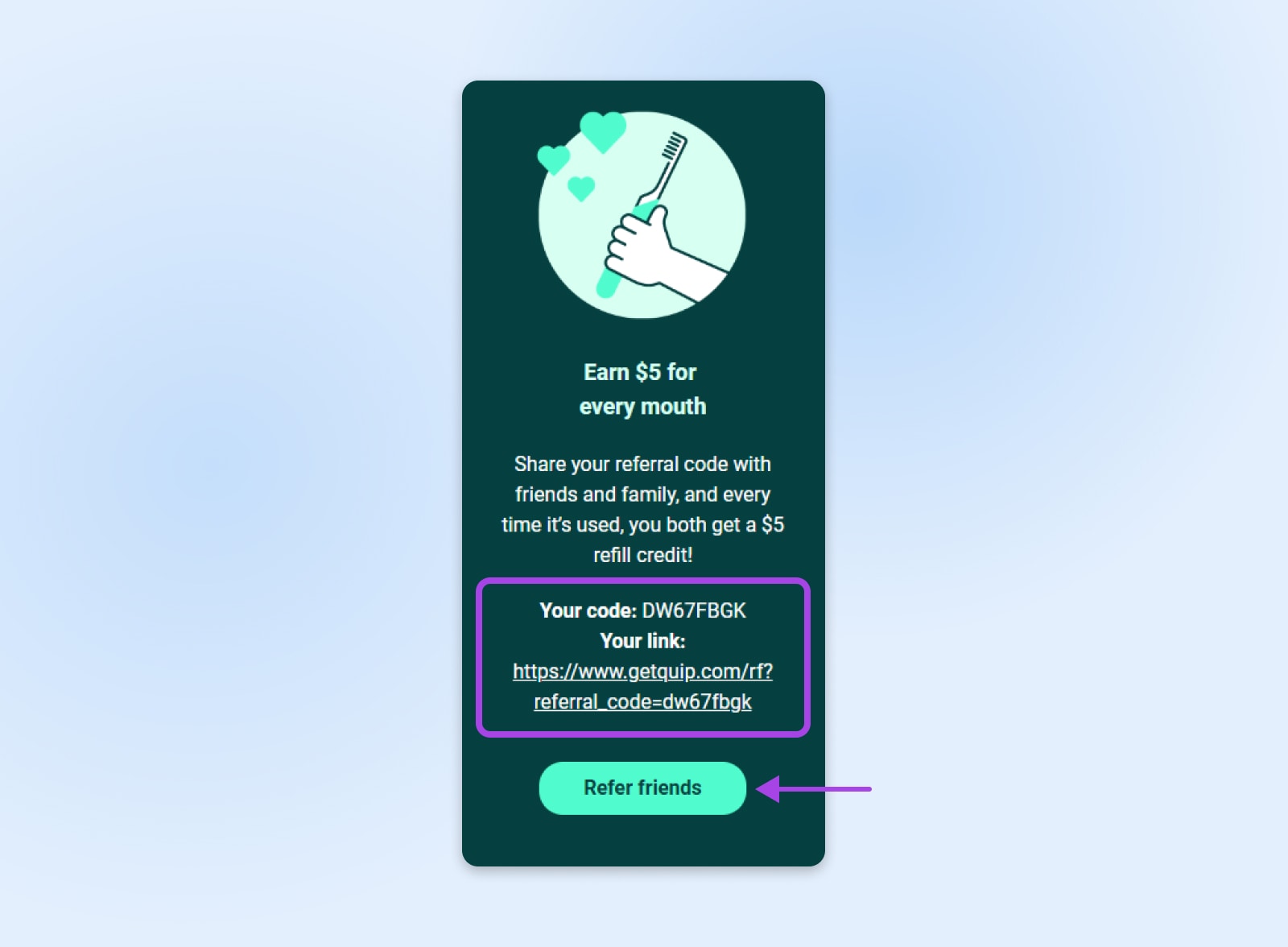
19. Use Social Media Ads
Social media marketing can be incredibly effective in reaching a broader audience that’s already interested in what you offer. And purchasing ads gives you an opportunity to target specific demographics, so you know you’re reaching your target audience.
Paid ads can be remarkably effective. Studies show that over 90% of internet users see them while browsing. With the right ad design, placement, and CTA, ads can be a great way to capture new sign-ups for your email list.
20. Collect Email Addresses At Events
Whether it’s a conference, a workshop, or a meet-and-greet, events are great places for growing your email list. When people engage with your brand in a live setting, they’re often more inclined to subscribe to your list. Make the process as easy as possible— think QR codes, a paper sign-up sheet, or a tablet where they can enter their details on the spot. Collecting emails at events not only grows your list but also connects you with subscribers who have already had a meaningful interaction with your brand.
And data shows that this works. 81% of trade show participants use email to follow up with leads they collect at in-person events.
21. Write A Guest Post Or Newsletter
Have you considered guest posting, guest blogging, or contributing to another newsletter? It opens up your brand to a whole new, larger audience, ripe for the picking (or in this case, subscribing). By sharing your insights, stories, or expertise on platforms other than your own, you’re not just showcasing your value. You’re inviting a whole new crowd to join your email list. Just be sure to include a CTA that directs readers back to your site to sign up.
Marketer Gregory Ciotti has shared case studies on how guest posting on sites with large, engaged audiences helped him build an email list with nearly 37,000 subscribers.
Guest Blogging
Guest blogging, also known as guest posting, is the act of writing and publishing articles on other people’s websites. Guest bloggers usually write for free in exchange for exposure to a new audience.
Read More22. Utilize Your Most-Visited Content
Your most-visited content is like the greatest hits album of your website—it’s what draws the crowd. So, why not capitalize on these fan favorites? Include clear, compelling CTAs for email sign-up on these pages. It’s a straightforward strategy that leverages your existing strengths.
23. Lock Your Most Popular Content
Ever considered playing a little hard to get? Locking your most popular or valuable content behind a sign-up form can be a powerful incentive for visitors to subscribe. This “content gating” turns your top-notch resources into exclusive content accessible only to those on your email list. It’s a trade-off—valuable information for their valuable email address.
It worked for QualityStocks, a site that publishes stock market advice. They didn’t even put a sign-up form over high-value gated content. They put a pop-up on their “About” page, asking visitors to sign up for their email list. The result? A 99% increase in subscriber growth over six months.
24. Offer Lead Magnets Or Content Upgrades
Similar to gated content, premium content, like lead magnets and content upgrades, can leave visitors wanting more, and willing to give you their email address to get it. Whether it’s an ebook, a checklist, a webinar, or a discount code, offering exclusive content in exchange for an email address can significantly boost your subscription rates. Tailor the additional content you offer to match the interests of your target audience, making the decision to sign up a no-brainer.
Backlinko used this strategy back in 2014, when the idea was still pretty new. Through content upgrades, they increased email signup conversions from 0.54% to 4.82%.
25. Use Heat Maps And Click Maps
Understanding how visitors interact with your website can be a game-changer for growing your email list. Using heat maps and click maps provides insights into where users are clicking, scrolling, and spending time on your site. This data is invaluable for optimizing the placement of your sign-up forms, CTAs, and action buttons, ensuring they’re in spots that garner the most attention.
This is a great way to use data to inform your strategy. Try a tool like FullStory to record user sessions and look for the best spots to place CTAs and forms.
26. Use A/B Testing
Another way to gain data into what’s working as you build your email list (and what isn’t) is to A/B test strategies. By comparing two versions of your sign-up forms, CTAs, or even the offers themselves, you can uncover what truly resonates with your audience. Test different headlines, button colors, form placements, or lead magnets to see which variations drive more sign-ups. Remember, even the smallest change can have a significant impact on your conversion rates.
A/B testing empowers you to make data-driven decisions, refining your strategy with precision to grow your email list more effectively. Try it with two strategies from this list to see what’s most effective with your audience!
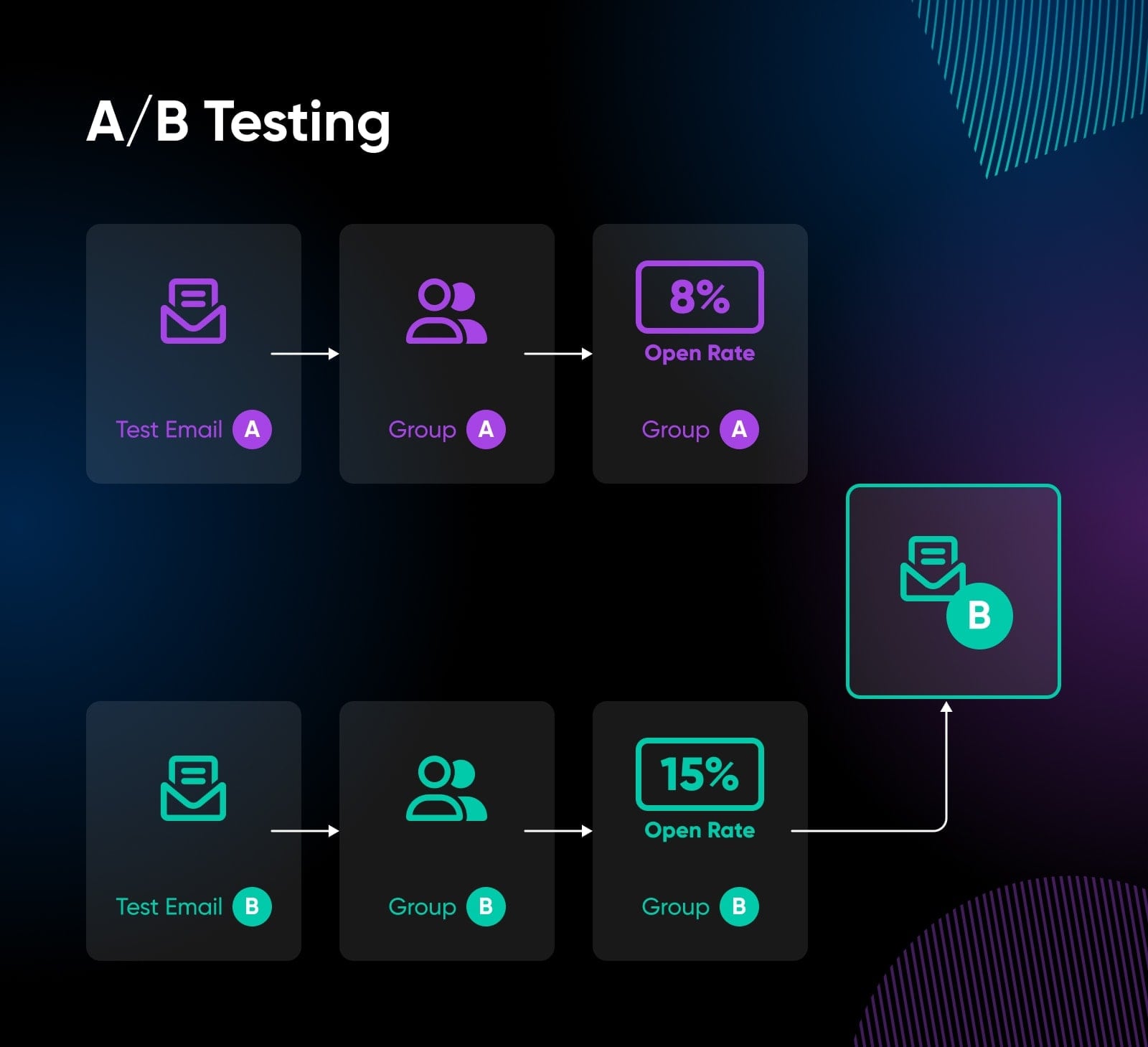
27. Deliver On What You Promise
When someone decides to give you their email address, it’s a gesture of trust; a belief in the value you’ve promised to provide. Whether it’s insightful content, exclusive offers, or a captivating series, make sure everything that lands in their inbox meets or exceeds expectations. This commitment to quality not only retains the email subscribers you’ve worked so hard to gain but also turns them into advocates for your brand. After all, a satisfied subscriber is more likely to recommend you to others, naturally growing your list through the most powerful endorsement of all: word of mouth.
The Key Takeaways
Building an email list is a multifaceted endeavor that goes beyond just collecting addresses — it’s about fostering a community of engaged followers who value what you have to offer.
Here are some of the most important points to keep in mind:
- Value is paramount – Whether through unique email content, lead magnets, or exclusive offers, the cornerstone of any successful email list is the value it provides to its subscribers.
- Engagement is more important than numbers – A smaller, more engaged email list can be more valuable than a larger, disinterested one. Focus on attracting subscribers who genuinely connect with your brand.
- Diversify your strategies– There’s no one-size-fits-all approach to list building. Utilize a mix of strategies, and A/B test them to find what resonates best with your audience.
- Keep your promises – Trust is the foundation of any relationship, including the one between you and your subscribers. Always deliver on what you promise, delivering content that aligns with their expectations.
- Make use of every touchpoint – From your email signature to guest posts, every interaction is an opportunity to grow your list. Make it easy and compelling for people to subscribe at every touchpoint.
Email list building is an ongoing adventure, one that evolves as your brand grows and the digital landscape shifts. The strategies outlined in this guide are your map. Remember, the journey doesn’t end once someone subscribes to your list. That’s just the beginning. It’s up to you to keep the conversation going, engaging your subscribers with content that educates, entertains, and inspires.
Get Content Delivered Straight to Your Inbox
Subscribe to our blog and receive great content just like this delivered straight to your inbox.